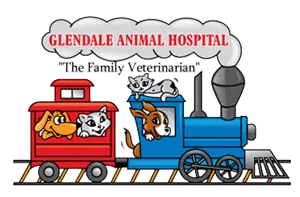DENTAL DISEASE IN DOGS AND CATS
Dental disease is the number one disease problem in pet cats and dogs! Although cats and smaller dogs have the highest incidence of periodontal disease, 95% of all dogs and cats will have some form of dental disease in their lifetime, many more than once!
WHAT IS DENTAL DISEASE AND HOW DOES IT START?
As your pet eats, food particles will naturally accumulate on and between tooth surfaces. Bacteria in the mouth digest these particles to form plaque, which is the sticky yellow film seen on the teeth. As this infection spreads, dental disease starts.
WHAT IS TARTAR, GINGIVITIS, AND PERIODONTAL DISEASE?
As enough plaque builds up, the bacteria cause infection of the gums known as GINGIVITIS; this is often seen as a red line along the teeth. If enough time passes, plaque hardens to form TARTAR, which in a way holds the infection to the tooth surface and helps push bacteria and debris under the gum line. PERIODONTAL DISEASE is this deeper infection of the teeth and tooth roots, which ultimately results in the loss of the infected teeth. Dental disease is graded on a 1-4 scale. A “1” would mean mild plaque and tartar buildup is present, “2” indicates gingivitis is present, “3” means that there is significant periodontal disease present and a “4” means that your pet has very advanced periodontal disease, abscessed/loose teeth present.
HOW DOES DIET EFFECT MY PETS DENTAL HEALTH?
Pets who eat exclusively hard food have fewer problems than pets that eat ANY AMOUNT of canned, semi-moist, or table foods. Food particles always are accumulating on the teeth, but soft food types seem to speed up the process as much as 3 times the normal rate! There are a few special diets, which are now made to clean the teeth better as the pet eats! Ask us about t/d tartar control food.
CAN BAD TEETH BE HARMFUL TO MY PET?
Dirty teeth may smell and look bad, but the damage that you don't see is much worse. The gum tissue has an extensive blood supply. When periodontal infection starts, these bacteria get into your pet's circulation and eventually leads to heart, liver, kidney, and bone and joint disease, including organ failure. Besides this, a bad tooth hurts just like in people!
WHAT ARE THE WARNING SIGNS OF DENTAL DISEASE?
Bad breath and possibly drooling or frequent licking may be the first signs. Inflammation of the gums (redness) with possible bleeding or obvious tartar buildup may be noted on an oral exam. Pus may be noted around teeth or from sores on the muzzle in advanced cases. Some pets may just not be doing well due to fighting the chronic infection and pain associated with dental disease.
WHAT CAN BE DONE TO TREAT MY PET?
Treatment for most pets involves scaling the plaque and tartar from the teeth even below the gum line. Teeth are then polished to smooth the surfaces and help prevent future damage. Cavities may need to be filled, root canals if any may be treated, or, if the teeth are badly damaged, extraction work may need to be performed. Antibiotics may also be dispensed to help rid your pet of existing infection. Dental work is all done under a general anesthesia so no pain is felt by your pet and so that the work can be done properly which would be nearly impossible with awake dogs and cats!
WHAT CAN BE DONE TO PREVENT FUTURE DENTAL DISEASE?
First, feeding only dry hard chow will greatly slow the buildup of plaque. Feeding ANY amount of softer food will mean more professional care will be needed. Rawhide or milk bones will also help.
Second, it may be possible to brush you pet's teeth on a regular basis. Start slowly by simply handling your pet's mouth several times a day. After your pet becomes acquainted to this, try brushing the OUTSIDE surfaces of the teeth with your finger, a wet gauze sponge, or even a small toothbrush. Again, as your pet adapts to this, they will not mind when you start using some type of paste or solution with your brushing. We most commonly advise the use of chlorhexadine solution or CET dentrifice. NOTE: not much attention is needed to inside surfaces of the teeth.
Third, remember that even though you may brush frequently, plaque and tartar still build up with time and regular professional care is needed to keep teeth in top shape.
CAN I USE MY TOOTHPASTE IN MY PET?
We caution you from doing this as most human products are high in detergent content which is not good for pets who don't always rinse and spit after brushing. We do have special solutions and diets available to make your job easier. This special attention will greatly improve your pet's health and your enjoyment of life together!


